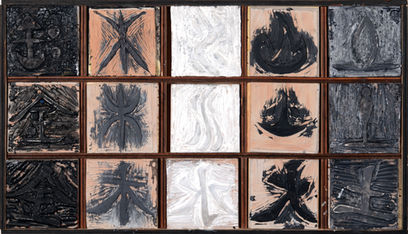Human | Nature

Civilisation of Chinese
This project explores the way Chinese language has changed and it reflection of our changing perceptions of the connection between man and nature.
The viewer’s attention is drawn to the left panel with the sculpture piece “Unity”. The two curvatures com-plement each other and create a sense of unity, like the movement behind Taichi. Inspired by Ivan Capote, “Decon-struction” is right next to “Unity”, wherein the pieces are seemingly broken off from “Unity”. Hanging from strings, they float off the ground, creating an image of dissected Chinese characters. Shapes and shadows allude to binary systems, hinting at the separation and proliferation of the modern age, contrasting harmony in “Unity”. My next exploration led me to “Directions”, an installation reminiscent of “Deconstruction”, through its arrangement of strings, framing, and the segmentation in multiples of 2. Chinese strings symbolizes connection and luck, with the colors red, black, blue, and white representing south, north, east and west in traditional culture. The ordered and chaotic strings with the firm frames convey although our perceptions of directions became more chaotic. I invite the viewer to question the inherent rules in Chinese culture that remain.
I further developed the relationship between language and landscape through ideas of evolution and mor-phosis in my next series. “Directions” is about human mapping, while “Landscape” refers to the nature. Inspired by Yang Yongliang, “Landscape” looks like a traditional Chinese ink painting but stamped using “Elements”, referring to the traditional typography. I use carved Lino in “Elements”, a technique, which alludes to the erosion of language. The two pieces suggest the five natural elements haven’t changed, but the composition changed, reflecting how hu-man development distracts us from nature.
“Lost” consists of nine “listen” breaking off, mimicking the vanishing tradition of Chinese papercuts, placed next to “Directions”. Both pieces have ordered framework with chaos inside. Nine is long-lived but also change-able in Chinese culture, thus representing the meaninglessness. I also used negative space to represent the “Lost” in meanings. The colors are bright, and the word is breaking off into chaotic shapes, which create dizziness and the viewer is almost “lost” in the piece. I used the evolution of complex ideas from “the seven emotions and six desires” for “Cycle”, inspired by Yael Kanarek. The red characters indicate the loss of meaning, while white ones haven’t, but all characters still refer to actual images, suggesting limitations of the nature of Chinese characters, forming a “Cycle”. This appears as opposite to “Unity’s” intentions, but both are smooth and curving with harmony.
Each work suggests a number, while bigger numbers represent more complicated ideas. The more complex the ideas behind the Chinese characters are, the more they have changed over time. However, my attention was drawn to our changing perceptions as well as the rules and traditions deeply inherent across this body of work.
2017 | The International Baccalaureate
Diploma Programme



 |  |  |
|---|---|---|
 |  |  |
 |





